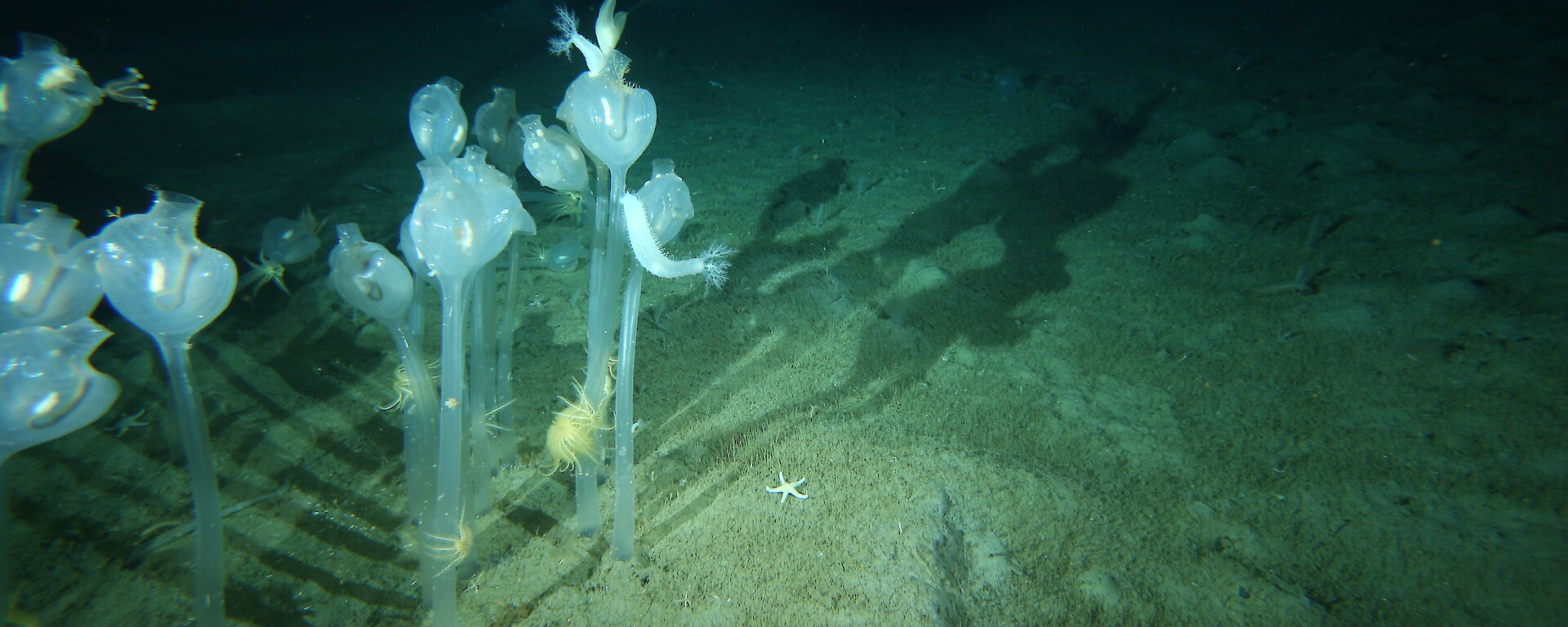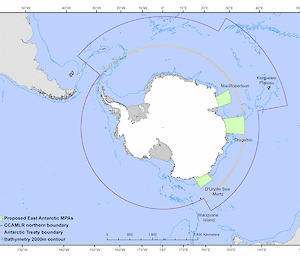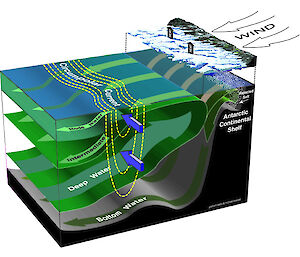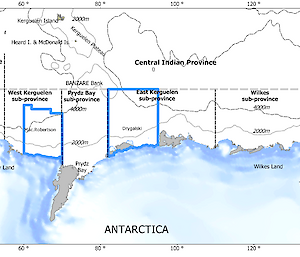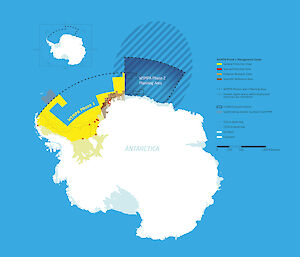Australia is a co-proponent of the East Antarctica and the Weddell Sea MPA proposals that are currently under consideration by CCAMLR. Co-sponsorship of both proposals consists of Australia, the European Union and its Member States, India, New Zealand, Norway, Republic of Korea, Ukraine, the United Kingdom, the United States of America and Uruguay. Australia also supports the Domain 1 (Western Antarctic Peninsula and South Scotia Arc) MPA proposal, which is proposed by Argentina and Chile. Additional details of these proposals are provided below.
East Antarctic Marine Protected Area (EAMPA) proposal
Australia, together with the European Union and its Member States, and co-sponsors India, New Zealand, Norway, Republic of Korea, Ukraine, the United Kingdom, the United States of America and Uruguay, are proposing an East Antarctic Marine Protected Area (EAMPA) to contribute to a representative system of Antarctic MPAs. Australia and the European Union and its Members States first proposed the EAMPA proposal to CCAMLR in 2012.
The proposed East Antarctic MPA would conserve examples of biodiversity in the high latitudes of the Indian sector of the Southern Ocean. The area contains distinctive deep water flora and fauna and supports important ecosystem roles, such as feeding areas for marine mammals, penguins and other seabirds. The proposed MPA would also provide scientific reference zones to assist with understanding the effects of fishing outside the MPAs as well as the consequences of climate change on Antarctic and Southern Ocean ecosystems.
There are many different biogeographic regions in the Southern Ocean and MPAs will play a significant role in conserving representative areas of each.
The East Antarctic MPA proposal includes a MPA Management Plan and identifies priorities for a Research and Monitoring Plan.
Key features of the MPA
The East Antarctic MPA proposal was developed in 2010 using the principles of comprehensiveness, adequacy and representativeness and has been endorsed and confirmed by CCAMLR’s Scientific Committee on three occasions as containing the best scientific evidence available.
- Comprehensiveness requires that the combined areas must be of sufficient size to encompass all types of ecosystems, particularly those from ecologically distinct provinces.
- Adequacy concerns the size and location of areas required to sustain the biodiversity inside the MPAs, as well as providing for resilience and adaptation to climate change impacts.
- Representativeness ensures that all biodiversity is represented and conserved in the MPA system.
Objectives of the proposed MPA
The proposed East Antarctic MPA aims to protect representative areas of open ocean and seabed biodiversity in East Antarctica. It contains the following three areas, comprising approximately 1 million square kilometres:
The MacRobertson area is representative of highly productive coastal and oceanic food webs in the West Kerguelen Sub-province, where marine mammals and birds forage during the summer. This area also includes a diverse set of seafloor ecosystems on the shelf, slope and seamounts representing the Central Indian Province. The size of the area has been determined by Adélie penguin foraging requirements, particularly during the critical breeding period. It also encompasses the foraging area of local Emperor penguin colonies.
The Drygalski area is important for its diverse sea floor environment on the shelf and slope, particularly in relation to canyons and ice shelves. It is representative of the coastal food web adjacent to the ice shelves and the greater oceanic food web adjacent to the Greater Kerguelen Plateau within the East Kerguelan Sub-province. This is the only representation of this type of food web in the proposed MPA. It also includes important foraging areas for Adélie and Emperor penguins, marine mammals and other seabirds.
The D’Urville Sea-Mertz area is an important area for our understanding of climate change, as a site of Antarctic Bottom Water formation, which drives global ocean circulation and traps greenhouse gases. Due to this process, the area supports a range of habitats not found anywhere else. Its seafloor values include a diverse set of habitats on the shelf and slope, particularly in relation to canyons, ice shelves and the Mertz Polynya. It also provides representative examples of other values within the Wilkes Sub-province, including coastal and oceanic food webs, a nursery area for Antarctic silverfish, and the foraging ranges of marine mammals and birds, such as Adélie and Emperor penguins. This area also has registered CCAMLR vulnerable marine ecosystems.
Scientific reference zones
The East Antarctic MPA proposal provides important scientific reference zones for measuring the natural variability and long term changes in Antarctic marine living resources and ecosystems, essential for achieving sustainable fisheries and for estimating the long-term conservation requirements of the region.
The area contains sites of long term monitoring of marine mammals, seabirds and the formation of Antarctic Bottom Water, as well as areas important for understanding climate change impacts on Southern Ocean ecosystems and processes without interference. The size of the MPA is determined by the important summer foraging requirements of marine mammals, Adélie and Emperor penguins, and other seabirds during critical breeding periods and by its value for monitoring large scale ecosystem processes.
A multiple use MPA
The proposal allows for multiple uses within the MPA. This means that activities, including fishing, will be allowed to take place so long as such activities will not adversely impact on the objectives of the MPA.
MPAs often use zoning to delineate where different activities may occur. The East Antarctic MPA relies on multiple-use-zoning primarily articulated through existing CCAMLR conservation measures. Such conservation measures define where and how activities such as fishing and research may occur throughout the CCAMLR Area. The East Antarctic MPA proposal includes provisions to guide the application of existing conservation measures and the assessment of any impacts within the MPA. It also includes additional zoning provisions.
Additional protection to innershelf depressions and embayments
The proposal extends an existing prohibition on exploratory fishing in depths less than 550 m to include all areas landward of the outer 550 m bathymetric contour, including areas that are deeper than 550 m in innershelf depressions and embayments. This seeks to conserve areas considered to be key continental shelf ecosystems.
A krill no-take zone
A prohibition on fishing for krill in the D'Urville Sea-Mertz area is proposed to monitor important environmental changes in this area since 2010.
Weddell Sea Marine Protected Area proposal
The Weddell Sea MPA (WSMPA) proposal was first presented to CCAMLR in 2016 by the European Union and its Member States. It would protect an area of about 2.2 million square kilometres in the Weddell Sea. This proposal is important because the Weddell Sea has largely pristine ecosystems, is home to a diverse range of marine living resources and is crucial for global ocean circulation and the world's climate. The Weddell Sea is also one of the last parts of the global oceans, where so far only few or no fishing activities have taken place, and it provides refuge for cold adapted species. This makes the Weddell Sea an ideal area to study ecosystem effects of, and resilience and capacity to adapt to climate change and ocean acidification, separate from the impacts of other human activities.
Domain 1 Marine Protected Area proposal
The Domain 1 (Western Antarctic Peninsula and South Scotia Arc) MPA proposal was first presented to the Scientific Committee of CCAMLR in 2017 by Argentina and Chile. This proposal has been under consideration by the Commission since 2018. It would protect approximately 670,000 square kilometres of representative habitats for marine living resources, preserve ecosystem processes, protect vital areas for zooplankton, fish, mammal and bird life-cycles, and designate areas for scientific research and monitoring.
Consideration of the East Antarctic and Weddell Sea MPA proposals
The East Antarctic MPA and Weddell Sea MPA proposals have been under consideration by the Commission since 2012 and 2016, respectively. It is not unusual for proposals of this nature to take time to achieve success. Australia continues to strongly support and work closely with other CCAMLR Members to continue to make progress and build support for the MPA proposals. The next opportunity to progress the proposals will be in the lead up to and at the annual meeting of CCAMLR in Hobart in October.

